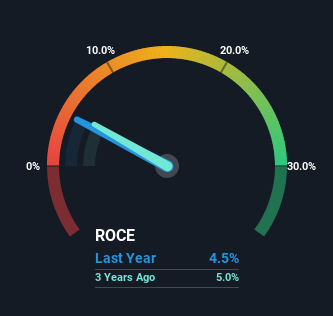- Hong Kong
- /
- Electric Utilities
- /
- SEHK:2638
Return Trends At HK Electric Investments and HK Electric Investments (HKG:2638) Aren't Appealing

What are the early trends we should look for to identify a stock that could multiply in value over the long term? Firstly, we'll want to see a proven return on capital employed (ROCE) that is increasing, and secondly, an expanding base of capital employed. If you see this, it typically means it's a company with a great business model and plenty of profitable reinvestment opportunities. Having said that, from a first glance at HK Electric Investments and HK Electric Investments (HKG:2638) we aren't jumping out of our chairs at how returns are trending, but let's have a deeper look.
What is Return On Capital Employed (ROCE)?
If you haven't worked with ROCE before, it measures the 'return' (pre-tax profit) a company generates from capital employed in its business. To calculate this metric for HK Electric Investments and HK Electric Investments, this is the formula:
Return on Capital Employed = Earnings Before Interest and Tax (EBIT) ÷ (Total Assets - Current Liabilities)
0.045 = HK$5.0b ÷ (HK$115b - HK$5.8b) (Based on the trailing twelve months to December 2021).
Thus, HK Electric Investments and HK Electric Investments has an ROCE of 4.5%. In absolute terms, that's a low return but it's around the Electric Utilities industry average of 4.2%.
See our latest analysis for HK Electric Investments and HK Electric Investments

In the above chart we have measured HK Electric Investments and HK Electric Investments' prior ROCE against its prior performance, but the future is arguably more important. If you'd like to see what analysts are forecasting going forward, you should check out our free report for HK Electric Investments and HK Electric Investments.
So How Is HK Electric Investments and HK Electric Investments' ROCE Trending?
There hasn't been much to report for HK Electric Investments and HK Electric Investments' returns and its level of capital employed because both metrics have been steady for the past five years. Businesses with these traits tend to be mature and steady operations because they're past the growth phase. With that in mind, unless investment picks up again in the future, we wouldn't expect HK Electric Investments and HK Electric Investments to be a multi-bagger going forward. That probably explains why HK Electric Investments and HK Electric Investments has been paying out 91% of its earnings as dividends to shareholders. These mature businesses typically have reliable earnings and not many places to reinvest them, so the next best option is to put the earnings into shareholders pockets.
Our Take On HK Electric Investments and HK Electric Investments' ROCE
We can conclude that in regards to HK Electric Investments and HK Electric Investments' returns on capital employed and the trends, there isn't much change to report on. And investors may be recognizing these trends since the stock has only returned a total of 36% to shareholders over the last five years. As a result, if you're hunting for a multi-bagger, we think you'd have more luck elsewhere.
One more thing, we've spotted 2 warning signs facing HK Electric Investments and HK Electric Investments that you might find interesting.
While HK Electric Investments and HK Electric Investments may not currently earn the highest returns, we've compiled a list of companies that currently earn more than 25% return on equity. Check out this free list here.
Valuation is complex, but we're here to simplify it.
Discover if HK Electric Investments and HK Electric Investments might be undervalued or overvalued with our detailed analysis, featuring fair value estimates, potential risks, dividends, insider trades, and its financial condition.
Access Free AnalysisHave feedback on this article? Concerned about the content? Get in touch with us directly. Alternatively, email editorial-team (at) simplywallst.com.
This article by Simply Wall St is general in nature. We provide commentary based on historical data and analyst forecasts only using an unbiased methodology and our articles are not intended to be financial advice. It does not constitute a recommendation to buy or sell any stock, and does not take account of your objectives, or your financial situation. We aim to bring you long-term focused analysis driven by fundamental data. Note that our analysis may not factor in the latest price-sensitive company announcements or qualitative material. Simply Wall St has no position in any stocks mentioned.
About SEHK:2638
HK Electric Investments and HK Electric Investments
An investment holding company, engages in the generation, transmission, distribution, and supply of electricity in Hong Kong Island and Lamma Island.
Undervalued with questionable track record.


